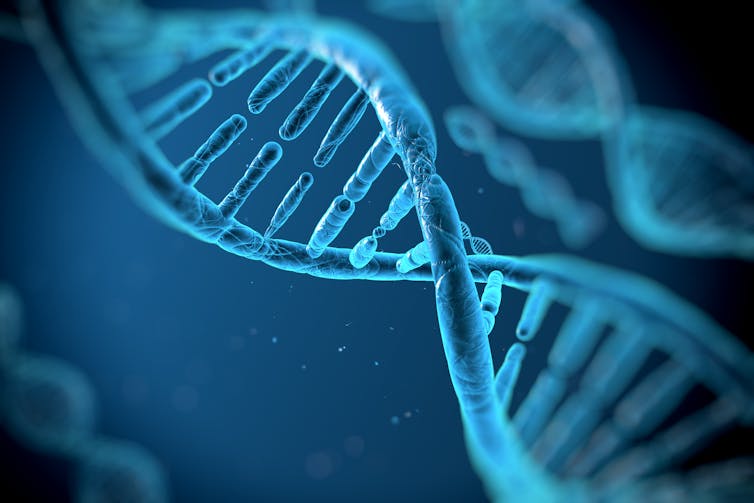
Written by: Lisa Smith, Jon Wetton, and Mark Jobling, University of Leicester; Heather D. Flowe, university of Birmingham
A huge global health challenge is physical and sexual violence against women and girls, affecting more than one third of all women globally.
One way to tackle this violent crime is through DNA profiling. Since its discovery in 1984, it has revolutionised criminal investigations and prosecutions. It has become a reliable tool for identifying perpetrators and supporting claims of sexual contact. It’s particularly effective when the perpetrators are either unknown to the victim, are repeat offenders, or in situations where they deny allegations of sexual contact.
But in places with displaced communities, and with high rates of conflict and poverty, cases of sexual violence are frequently under-reported and victims rarely get justice. This is often because there aren’t effective responses to sexual violence and because DNA often can’t be recovered in these settings.
Kenya is a country that faces some of these challenges. As a result, prosecution levels for sexual violence are extremely low. While 14% of Kenyan women aged between 15 and 49 have experienced sexual violence at least once in their lifetime, very few cases get reported to authorities or go to court. We learned from the Nairobi Women’s Hospital that fewer than 10% of the 4000 rape cases reported were to the police.
Of the crimes reported to the police, more than half are committed by a stranger to the victim. DNA evidence could be invaluable in identifying the perpetrator in such cases. But it’s often not recovered due to a lack of access to trained medical professionals and facilities.
As part of a project to overcome barriers to DNA evidence collection in these environments, my colleagues and I are developing innovative recovery techniques. These won’t need medical expertise and can support criminal investigations and prosecutions. One of these products is a self-administered, intimate DNA swab.
We challenge the prevailing assumption that intimate DNA swabs must be collected by trained medical professionals for evidence. And, after testing a self-administered DNA swab in a proof-of-concept study, our results show that women can collect DNA themselves after sexual violence.
We have discussed this approach with stakeholders from across Kenya’s criminal justice sector. It is clear from these engagements that that there is a significant need for such swabs, and for other ways of collecting DNA.
Evidence kits
DNA is often not collected in low-resource environments because women can’t get to medical facilities or trained personnel. Survivors may also be reluctant to be medically examined – often by male doctors – and the procedures they go through to report the abuse might not be safe.
Adopting self-examination DNA collection techniques can help to overcome some of these barriers. We are still working on the final design of the swab but the prototype we used in the proof-of-concept study was very similar to a tampon.
The swab must be comfortable to use, safe for the user and have instructions that are easy to follow. We will use a specially designed applicator, to reduce the risk of contamination, and tamper-proof packaging to meet international criminal justice system standards.
To test the effectiveness of a self-administered swab we recruited heterosexual couples who engaged in consensual, unprotected sex. Female participants then used self-administered intimate swabs between 12 and 36 hours after intercourse. This helped us to determine whether this method could successfully recover male DNA.
We analysed the results and confirmed that the self-administered swabs could successfully collect male DNA up to 32 hours after intercourse. Only one of the 14 samples failed to detect the male DNA profile; this was the swab that was used after the longest delay since intercourse (34 hours).
Barriers to forensics
Following the study, we travelled to Nairobi. We wanted to discuss the barriers to forensic science and the design of DNA kits with key stakeholders in Kenya. These included NGOs, the Directorate of Criminal Investigations and the Government Chemist.
Based on our discussions, the DNA kits will include the intimate DNA swab, packaging for clothing, mouth rinses, and swabs for external use. The kits will ideally be distributed to clinics so they can be used when cases of sexual violence are reported.
We are working in Kenya because there is some forensic infrastructure and the possibility of developing a national DNA database in the near future to support criminal investigations. Kenya is also increasingly committed to tackling sexual violence. These factors make the country a promising environment for implementing these novel kits and we hope to scale up this activity in other countries and environments in the future.
But despite these positive factors, Kenya still has a long way to go. Its criminal justice system is impeded by insufficient budgets. There’s inadequate forensic science infrastructure, poor training, and considerable case work backlogs.
This means that in remote areas and during times of conflict, like the 2007 and 2017 elections when thousands of women were raped, survivors aren’t able to access medical facilities and trained professionals.
In these circumstances, the self-administered DNA kit we’re designing would make it possible to obtain valuable DNA evidence when there are no other means of doing so.
Charlotte R King and Laura Stevens contributed to the writing of this article.![]()
Lisa Smith, Professor of Criminology, University of Leicester; Heather D. Flowe, Senior Lecturer in Forensic Psychology, University of Birmingham; Jon Wetton, Co-Director of Alec Jeffreys Forensic Genomics Unit, University of Leicester, and Mark Jobling, Professor of Genetics and Wellcome Trust Senior Fellow, University of Leicester
This article is republished from The Conversation under a Creative Commons license. Read the original article.
WOULD YOU LIKE TO SEE MORE ARTICLES LIKE THIS? SUBSCRIBE TO THE ISHI BLOG BELOW!
SUBSCRIBE NOW!

